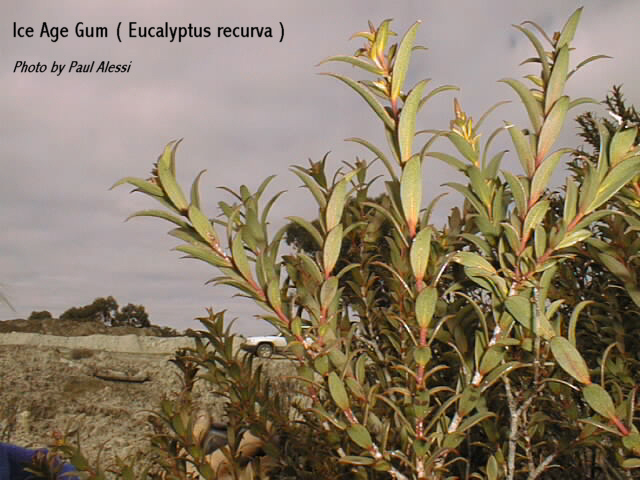
Wild Windellama
by Paul Alessi
February 2005
When I was asked to continue the
regular column
in the Windellama News by the late Dr Carina Clarke
called "Wild Windellama" I not only felt honored but
more than a little apprehensive that I could write anything that
would come close to the high standard that Carina had produced
over
the years, Wild Windellama was the title of her column
and it is out of respect for it originally being her idea,
and our friendship that I will continue with this name.
Carina and I shared many
bushwalks together where we would
compare our observations of plants and animals, my knowledge
is mostly botanical but Carina had such a great understanding
of all the natural world that a walk through Wild Windellama in
person with her was always something to remember. We are most
fortunate that she brought to us so much of her knowledge through
this column and some of these articles have been reprinted in
the Windellama News since her sad passing last year.
Just as an introduction, my wife
Sharon and I moved to Windellama
from Helensburgh south of Sydney over 20 years ago, originally
a suburban boy I developed a love of the bush at the age of 12
on hikes in the Royal National Park near Loftus in Sydney with
a school mate named Dean that lived on the edge of this great
wilderness, we never became
lost more through good fortune than planning but always felt at
home in the bush
imagining we were explorers from earlier days, I have never been
lost in my
many wanderings in Windellama either but did become
geographically challenged
or as I like to say "misplaced" on one occasion looking
for Ben Hall's cave
in rugged country near the Shoalhaven Gorge but I'll leave that
story for another time.
The eastern part of Windellama
was largely left in it's natural state due to poor soils
and unpredictable rainfall but being on the transition zone
between coastal and western
vegetation zones this area is certainly rich in biodiversity.
Windellama has many small
pockets of differing soil types, topography and micro-climate we
can find areas
resembling either coastal, western or even almost sub alpine
vegetation.
In The Shoalhaven River Gorge,
there are gullies of rainforest species such as
Sandpaper Figs (Ficus coronata), Pencil Orchids and great vines.
On the plateau above are large sandy expanses
that in spring could be somewhere in the Western Australian with
the colour
and profusion of the wildflowers, among them a member of the pea
family
Bossiaea oligosperma that is common in Windellama but in the
world very rare
and now classified as a threatened species. This plant forms
almost inpenetrable
woody thickets, and it's flowers are mostly bright orange with a
dash of red,
also growing here are large and centuries old Urn Fuited
Peppermint Gums
(Eucalyptus piperita var.urceolaris) and although once common in
Sydney occur nowhere
else in the southern highlands that I have found. We are lucky
enough to have very large
specimens of Coastal Grey Box (Eucalyptus bosistoana) some of
which were used to build the
bridge over the Nerrimunga Creek on the Spa Road over 60 years
ago and still
strong enough to carry the much larger loads now moved by road
transport than when it was
designed including large bulldozers and full size train
carriages.
On the plains closer to Goulburn
and Tarago there are open grasslands
like those of the Monaro covered in tall spear grass (Austrostipa
bigeniculata)
and in sheltered frosty gullies and creeklines there are large
colonies of Snow Tussock
(Poa labillardierii) Snow Gum (Eucalyptus pauciflora) and Black
Sallee (Eucalyptus stellulata),
these two Eucalypts being the most common types above the
snowline in the Snowy Mountains,
a hint maybe to a colder past in Windellama, a notion supported
by the remarkable occurence
in Windellama of two of the five known specimens of the world's
rarest gum tree " Ice Age Gum"
(Eucalytus recurva) believed to be a survivor from the last Ice
Age.
For the past 15 years we have
made our living from native plants and I hope to be able
to bring something interesting to this column each month as
certainly Carina did.
In one of the the next issues I
hope to write about Koalas, they live here in Windellama in
small numbers as part of the larger habitat area comprising most
of the Shoalhaven River catchment,
at least 4 Koalas have been seen and photographed in Windellama
in the the last 2 years.
Little is known about their
diet, distribution and population numbers in this part of
Australia
and I am fortunate to have taken part in two NPWS Koala surveys,
one in Bungonia
and another in Windellama with some of Australia's leading Koala
researchers who are
very interested in Shoalhaven Koalas. The highlight of these
surveys was finally seeing a
Koala in the wild. My wife Sharon had seen two Koalas near our
home in Windellama
in the 1980's. Last year I saw my second wild Koala and this one
was in Windellama,
the photo in this article is a frame taken from video footage.
Some other articles I hope to
write for Wild Windellama will deal with bush tucker,
bush medicine, native grasses and timber trees. Next months
article will be on Stringybarks.
I can be contacted on 48445149
or palessi@tpgi.com.au


Copyright Paul Alessi 2005